The urban population of Scotland in the 18th c.
- Alexander Webster
- Scottish Population Statistics
- The Trades of the Street
- Holyroodhouse in Edinburgh
It is thanks to a clergyman from Edinburgh, Alexander Webster (1707-1784) that the first serious census of the Scottish population, entitled Account of the Number of People in Scotland, 1755, was carried out in 892 parishes of Scotland in 1755. This manuscript, which is in the National Library of Scotland in Edinburgh, was published for the first time in 1952 by the publisher James Gray Kyd under the title Scottish Population Statistics: Including Webster’s Analysis of Population 1755 (Edinburgh: Printed by T. and A. Constable for the Scottish History Society, 1952).
Given the extreme difficulties that a detailed count of the inhabitants of Scotland in the 18th century presented, Webster’s statistics, despite an inevitable lack of rigour in the calculations, are the only ones that can be considered seriously before the official population census in 1801.
It is possible to establish several facts in the light of Webster’s figures. In 1755, the population was essentially rural and only four towns: Edinburgh, Glasgow, Aberdeen and Dundee, had more than 10,000 inhabitants, which corresponded to 9.22% of the population. The development of trade and industry was to provoke the progressive depopulation of the countryside to the benefit of the towns. In 1801, 17.59% of the population was concentrated in seven large towns of more than 10,000 inhabitants: Glasgow, Edinburgh, Paisley, Aberdeen, Dundee, Greenock and Perth.
In 1755, Edinburgh was amongst the ten largest towns of Scotland, ranked first place with its 57,000 inhabitants, and preceding in this case its rival Glasgow (31,700 inhabitants). Nevertheless, due to its extraordinary growth in trade, Glasgow was to become the most populated town of Scotland at the start of the 19th century. The official 1801 census in effect ranked it at the head of Scottish towns with 83,700 inhabitants, closely followed by the capital whose population reached 81,600 inhabitants at that time
Edinburgh was administered by a Provost.
Its administration is praised by one of Smollett’s characters.
Alexander Webster (1707-1784)
Son of the Scottish minister James Webster, Alexander Webster was born in Edinburgh in 1707 and did his theological studies in the capital. In 1733, he was appointed minister at Culross, then obtained a transfer to Tolbooth Church, Edinburgh, in 1737. The same year, he married the daughter of Colonel John Erskine of Alva, with whom he had six sons and a daughter.
Webster’s pronounced taste for mathematics prompted him to submit to the Presbyterian Church General Assembly in 1742, a project for the payment of an allowance to the widows of church ministers, which was based on the results of a survey conducted in all the presbyteries of Scotland. Webster received thanks for his works from the General Assembly in 1744. In August 1748, he was attached as Chaplain to the Prince of Wales service and in May 1753, he was elected president of the Presbyterian Church General Assembly.
As a census of the Scottish population had never been taken before then, the government commissioned Alexander Webster to carry out a count in 1755. Webster sent a list of very precise questions to the ministers of each parish, and from the answers obtained, he was able to estimate the Scottish population at 1,265,380 inhabitants.
The 24th November 1760, Webster obtained the title of Doctor of Divinity from the University of Edinburgh. In June 1771, he was appointed General Collector of funds for the widows of ministers, and that year he received the mark of honour of becoming one of the titular Scottish Chaplains for his Majesty George III and Dean of the Royal Chapel. He died on the 25th January 1784, eighteen years after the death of his wife. The author of several religious works, his name is above all associated with the ’1755 Census’, the first more or less reliable count of the Scottish population before the official census of 1801.
Scottish Population Statistics
| The urban population in Scotland in 1755 according to the calculations of Alexander Webster | |
| Edinburgh (Midlothian) | 57000 |
| Glasgow (Lanark) | 31700 |
| Aberdeen (Aberdeenshire) | 15600 |
| Dundee (Angus) | 12400 |
| Inverness (Inverness-shire) | 9700 |
| Perth (Perthshire) | 9000 |
| Dunfermline (Fife) | 8500 |
| Paisley (Renfrew) | 6800 |
| Dumfries (Dumfries) | 4500 |
| Kilmarnock (Ayr) | 4400 |
| Montrose (Angus) | 4100 |
| Falkirk (Stirling) | 3900 |
| Greenock (Renfrew) | 3800 |
| The urban population in Scotland in 1801 (official census) | |
| Glasgow (Lanark) | 83700 |
| Edinburgh (Midlothian) | 81600 |
| Paisley (Renfrew) | 31200 |
| Aberdeen (Aberdeenshire) | 27400 |
| Dundee (Angus) | 26800 |
| Greenock (Renfrew) | 17400 |
| Perth (Perthshire) | 14800 |
| Dunfermline (Fife) | 9900 |
| Falkirk (Stirling) | 8800 |
| Inverness (Inverness-shire) | 8700 |
| Kilmarnock (Ayr) | 8000 |
| Montrose (Angus) | 7900 |
| Dumfries (Dumfries) | 7200 |
The Trades of the Street in Edinburgh
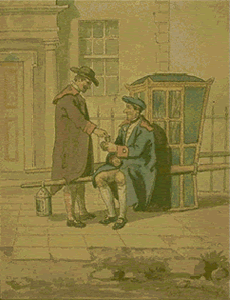
- A Sedan Chair and Porter
- Sedan chairs may be seen in Bath.
by David Allan (1744-1796)
(National Galleries of Scotland)
[click on the picture to enlarge it]
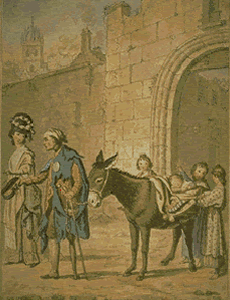
- A Peg-Legged Beggar with Donkey and Children Asking Lady for Alms outside City Gate (“Charity”)
- by David Allan (1744-1796)
(National Galleries of Scotland)
[click on the picture to enlarge it]
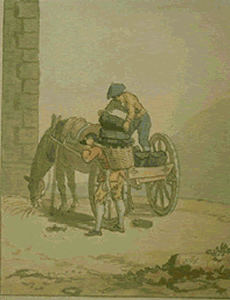
- A Charcoal Dealer, his Boy and Cart
- by David Allan (1744-1796)
(National Galleries of Scotland)
[click on the picture to enlarge it]
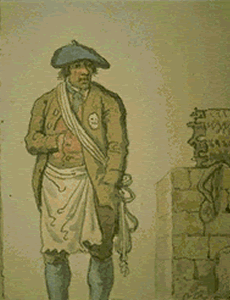
- A City Porter or Cadie
- by David Allan (1744-1796)
(National Galleries of Scotland)
[click on the picture to enlarge it]
David Allan also made views of High Street. One of Smollett’s characters, Jerry, gives an account of the trades of the street, the cawdies.
Holyroodhouse in Edinburgh
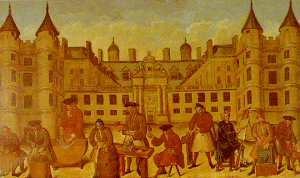
- Roderick Chalmers, The Edinburgh Trades at Holyrood 1720
- (Collection of the Trades Maiden Hospital on loan from the Joint Incorporation of Wrights and Masons of Edinburgh)
The painter has given prominence to his own trade since he is seated on a high-backed chair and wears a full-bottomed wig.
[click on the picture to enlarge it]
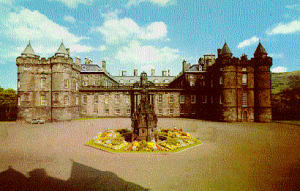
- The palace of the Kings of Scotland
- It is shown in a painting by Chalmers, and it is described by Smollett.
[click on the picture to enlarge it]

